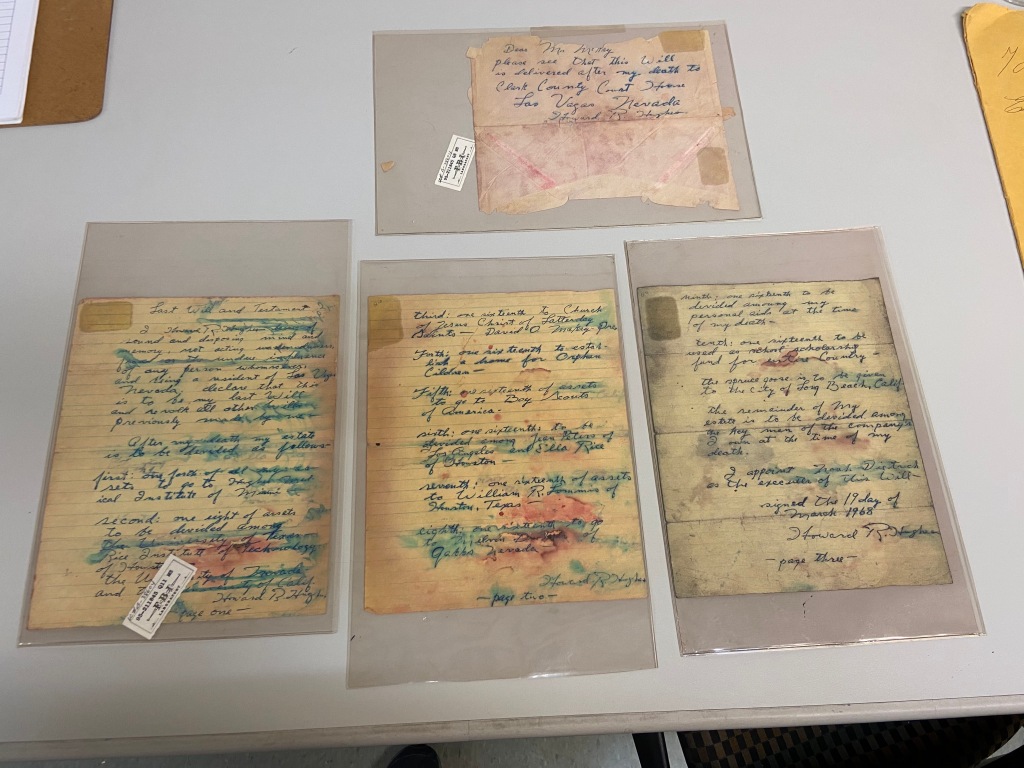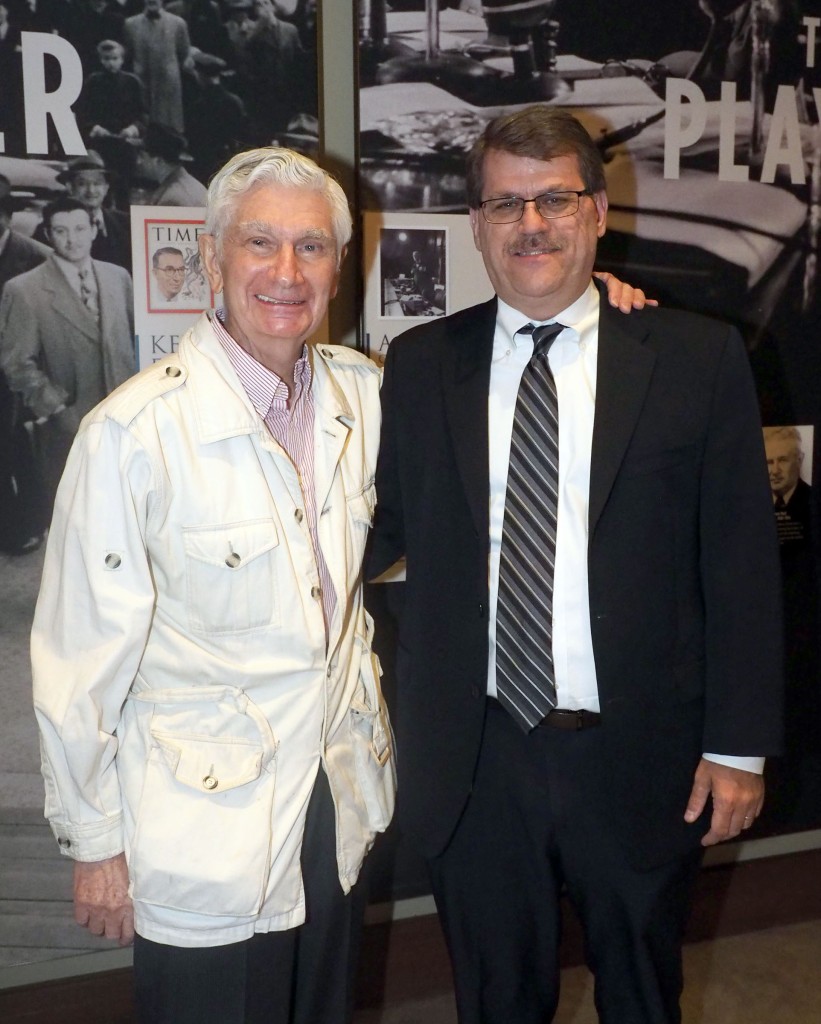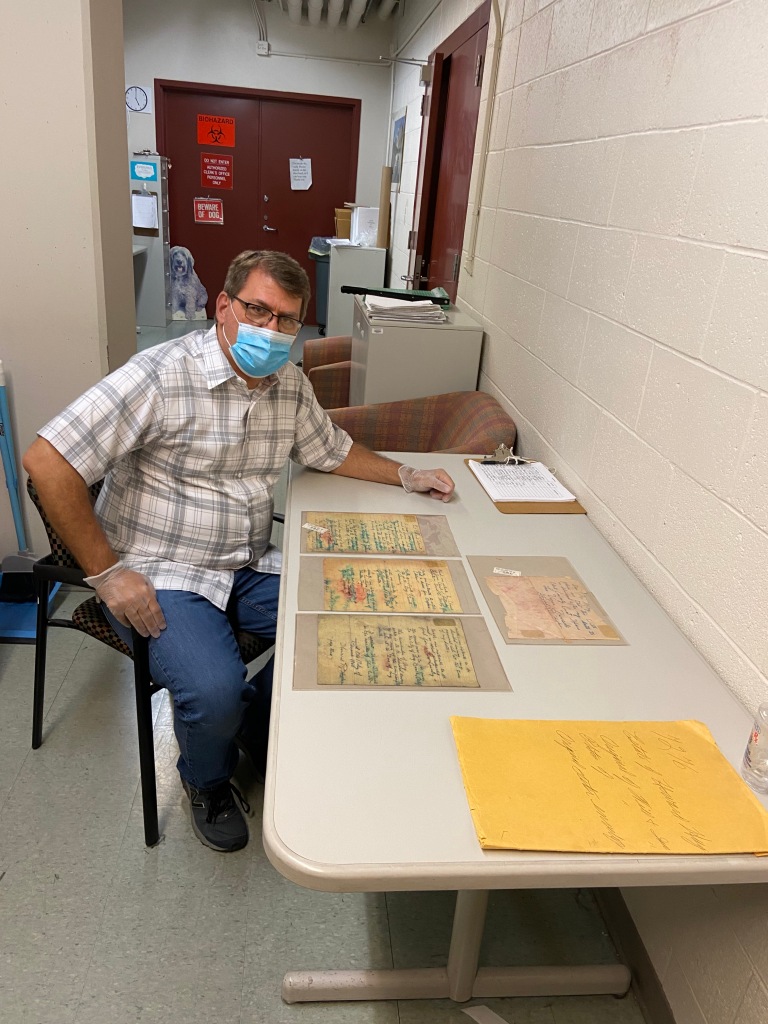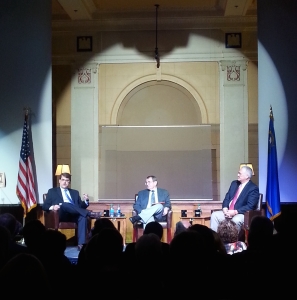Las Vegas Book Festival 2023

The Las Vegas Book Festival is coming up on Saturday, October 21, at the Historic Fifth Street School in downtown Las Vegas. I will be moderating a panel titled “Las Vegas and the Mob,” featuring three authors of great new books. The festival will run from 10 a.m. to 6 p.m. This particular panel discussion is set for 2:15 p.m.
Up close and personal with the Mormon Will
In the television series The X-Files (1993-2002), FBI agents Fox Mulder (David Duchovny) and Dana Scully (Gillian Anderson) are assigned to investigated odd and unsolved cases. Mulder leans toward believing in the paranormal, while Scully, a medical doctor, is a skeptic. I bring all this up as context to discuss one of the iconic images from the series: a poster on the wall in Mulder’s office. The poster shows an unidentified flying object hovering in a clear sky above a copse of trees. The bottom half of the poster says, simply, “I WANT TO BELIEVE.”
This phrase, I think, can be applied to the mindset of a lot of people these days. They want to believe in conspiracy theories. They want to believe in ghosts. They want to believe the mob killed Kennedy. They want to believe these kinds of things no matter how little real evidence there is to support them. I have heard people say, more or less, “I don’t care what your evidence says, I believe this to be true.” It’s pretty difficult to counter such a statement.
To be clear, being a skeptic does not have to mean immediately dismissing all exotic ideas and theories. For example, while I have never had a paranormal experience in 55 years on the planet, I am open to the possibility that more is going on than the human senses can detect. I prefer leaving that door open a crack rather than shutting it, locking it and throwing away the key.
I took the same approach when I began researching the story of Melvin Dummar and the Mormon Will for my book on Howard Hughes. From the start, I was skeptical of Melvin’s story but I left the door open to the possibility that it could be true.
As I recount in my book, I interviewed Melvin for several hours in his room at the Clown Motel in Tonopah, Nevada. Melvin told me his story of picking up an injured older man on a dirt road south of Goldfield in late December 1967. Melvin said he took the man to Las Vegas and dropped him off at the Sands Hotel. He said that during the trip, the man told him he was Howard Hughes.
Melvin then told me about how, after Howard Hughes died in 1976, he came into possession of a handwritten will allegedly written by Hughes, and how he took it to the Mormon Church headquarters in Salt Lake City. The church, in turn, delivered the will to the court in Las Vegas. The will was taken seriously enough, especially by the individuals and entities who stood to benefit, that it became the focus of a trial to determine its validity. One of the potential benefactors was Melvin, who would become rich thanks to the kindness he offered the old man he picked up in the desert. However, the court did not validate what came to be known as the Mormon Will. Lacking a legitimate will, Hughes’s holdings were turned over to his heirs, led by a cousin, Will Lummis.
Although the will was deemed to be a fake, which strongly suggests Melvin was involved in a nefarious scheme, many people to this day believe his story. Melvin became a working-class hero, an earnest man whose one chance at the brass ring was thwarted by the powers that be. This view of Melvin was enhanced by the 1980 movie Melvin and Howard, which follows the story pretty much as Melvin told it.
I and many others have written extensively about the Mormon Will without having actually looked at it. Pictures of the will have appeared in newspapers and books, of course, but few people have actually gone to the courthouse in Las Vegas, where it is housed, to view the document up close.
I recently did this, and it was worth the time and effort.
I pursued a personal viewing of the will at the urging of Paul Rhoden, son of Harold Rhoden, the key lawyer involved in the Mormon Will case. Harold Rhoden represented Noah Dietrich, the former Hughes executive who was named executor of the estate in the will. Why Paul Rhoden and his brothers remain interested in the will all these years later is for them to explain. It appears they believe the will is real, and that new technologies could yield information to support this assertion. Whatever the case, my interest in looking at the will was simply part of my ongoing research, which, for better or worse, has not ended with the publication of two editions of my book about Hughes.
After seeking and receiving approval from District Court officials to look at the will, on September 18th, 2020, I walked into the Clark County Regional Justice Center in downtown Las Vegas, met the employees in charge of such things, and was soon seated at a table with the three pages of the will and a related envelope encased in plastic in front of me.

This might not seem like a big deal, but for someone who has been writing about this legendary document for many years, it was a thrilling experience. As the pictures accompanying this essay show, the handwriting on the document is badly smeared. This, I am told, is a result of the chemicals used in the FBI’s fingerprint analysis of the document. The greenish smears clearly come from the ink in the pen used to write the will. The red blotches are more difficult for the layman to comprehend, but they apparently resulted from the process of attempting to procure latent fingerprints from the paper.
Despite the smearing, the will remains legible, confirming the handwritten words so carefully studied for the trial and in the years since. The biggest indicators of the will’s forgery are evident: the use of the media-created nickname “spruce goose” to describe Hughes’s giant H-4 airplane; the misspelling of the last name of Hughes’s cousin as “Lommis,” not “Lummis”; the highly unlikely selection of Dietrich as executor, considering Hughes had fired Dietrich 11 years before the will was allegedly drafted. And so on.
But all that is old news. For me, the biggest takeaway from seeing the will in person was the nature of the paper. Up close, it is clear that the paper used for the will is of the type a student would use for an elementary school assignment. It is cheap paper with wide rules. It is the last kind of paper one would expect one of the world’s richest men to have at his disposal.
Hughes did not have children, and he seemed to have little interest in them. After he became a recluse, he never came into contact with any children, and his aides, if they had children, never brought them to work.
Further, we know that especially in his years living at the Desert Inn in Las Vegas, Hughes was a prolific memo writer, and that he exclusively used yellow legal pads for this purpose. Why would he use cheap, wide-ruled school paper to write a will when he had an ample supply of yellow legal pads stacked beside his chair?
I’m sure my observations about the paper on which the will was written are not going to change minds around the world concerning the Mormon Will’s validity. If people can overlook the use of “spruce goose” in the will, they surely can concoct a rationale for Hughes to write the will on children’s school paper.
The research will continue. Just as researchers continue to look for new clues to who killed Jimmy Hoffa, I look for fresh information about the life and times of Howard Hughes. Next, I would like to take a deeper look into the Mormon Will case file to see if it yields anything interesting. If I find anything noteworthy, I will report it here.
Howard Hughes bio published

The revised and expanded edition of my Howard Hughes biography was released March 11th. The title is Howard Hughes: Power, Paranoia, and Palace Intrigue. The publisher is University of Nevada Press.
I am proud of the book, which is longer and better than the first edition, which was published by Stephens Press in 2008. I added 29,000 words, and improved and updated the original 100,000.
Obviously this is a difficult time to promote the book. But I’ve been doing some great radio interviews. Most notably, I recently had the opportunity to talk about the book for two hours on “Coast to Coast AM,” which has a massive audience across North America. (Thank you to longtime friend and colleague George Knapp, who hosts the show once a month, for inviting me.)
Hughes was a fascinating character, and his story still resonates today on several fronts. I hope those who get and read the book enjoy it.
Sel Raab, author of canonical Mafia history, speaks at Mob Museum
I had the opportunity to spend some time with Sel Raab when he spoke at the Mob Museum earlier this month. A retired reporter, Raab’s career was highlighted by 25 years at the New York Times, where he became one of the country’s foremost authorities on the New York Mafia. His most well known book is Five Families: The Rise, Decline, and Resurgence of America’s Most Powerful Mafia Empires, which is required reading for anyone interested in mob history.

Selwyn Raab poses with Geoff Schumacher before he speaks at the Mob Museum on Thursday, Nov. 17, 2016. (Photo by Jerry Henkel)
Mob Museum panel: What happened to Jimmy Hoffa
Panel discussion on the Bugsy Siegel murder
Great venue, interesting discussion.
The first non-triple-digit summer day in a long time
It’s not hot today. The high is supposed to be 84. There could be thunderstorms, although in Las Vegas that can mean you get a 30-second sprinkle and call it done. This is the first time we’ve had a day like this in months. It’s been a hot, dry summer. This is not terribly unusual for Las Vegas, but it’s definitely a significant contrast with Iowa, where we were for three years previous. I don’t mind the heat, but I do mind the climatological monotony.
My work at the Mob Museum is going very well, but Las Vegas generally is not as hospitable as one would like. With the endless violence reported on the news, the ubiquitous homeless people approaching us in parking lots and the thoughtless and angry motorists on the streets, not to mention the recent report ranking Nevada 50th in education, we are less than impressed with our new-old home.
But summer is weird. Things might look better before too long. Fortunately, it’s that time of year when some things return to normal. In a week, our younger daughter will return to Iowa State University for the fall semester. In two weeks or so, our son-in-law will return to the classroom to teach eighth-graders. At month’s end, college and pro football will start their regular seasons. In mid-September, the fall TV season will kick off, bringing back a handful of shows we like. And by late September we might start feeling the first signs of fall.
Since I don’t blog that often, I should throw in a few updates:
– The Nevada sesquicentennial book launched in May with a great event at the Clark County Library. The book has been well received and is selling well. In fact, the first printing is nearly sold out. We’re not sure yet whether there will be a second printing.
– I wrote a long essay for this year’s Las Vegas Writes book. The book’s theme is “Lost and Found,” and I wrote about lost and found Nevada historical documents and artifacts. The book will debut at the Vegas Valley Book Festival in October.
– Speaking of the book festival, I am scheduled to participate in two panel discussions there, one on the Las Vegas Writes book and one on the Nevada sesquicentennial.
– I’ve been writing some essays and book reviews for Desert Companion, Nevada Public Radio’s monthly magazine. My old friends and colleagues Andrew Kiraly and Scott Dickensheets run that operation, and I enjoy writing for them.
– I recently completed a big project to rescue the Las Vegas CityLife and Las Vegas Mercury hard copy archives from the Las Vegas Review-Journal, which wanted to dispose of them, and donate them to the Nevada State Museum. There were many car trips from the R-J to my house, where the 75 banker’s boxes of papers were stored in my garage, and then there were many more car trips from my house to the museum. Thanks to museum director Dennis McBride for taking an interest in preserving these publications.
Back to Las Vegas, in a very different line of work
When I moved from Las Vegas to Ames, Iowa, three years ago, several people told me, “You’ll be back.” At the time I thought it was a rather presumptuous prediction, built on the idea that Las Vegas is such a desirable place to live that I would be disappointed anywhere else. But here I am, three years later, back in Las Vegas, and happy to be here.
After 25 years in the newspaper business, I have leaped into a whole new industry. I’m the director of content development for the Mob Museum in downtown Las Vegas. Although museums are very different from newspapers, I think my skills and experience translate well into what I am doing now. I am working on a bunch of different things but they all revolve around history and storytelling.
I intend to continue writing books and articles, but my primary focus will be on contributing in whatever ways I can to improve and grow the museum. The possibilities are vast, exciting and daunting. There is no shortage of work to do and ideas to pursue.
I also hope to revive this blog a bit after a long period of inactivity.
A Nevada sesquicentennial book update
The designer, Sue Campbell, and I plan to send the book to the printer by mid-December. We are in the final stages now. I received the first draft of the layout today, and now the work begins to refine the look, proof the text and finalize the photo selections.
The book will be released in late May. It’s being published by Stephens Press but it will be marketed and distributed by the University of Nevada Press.
“Nevada: 150 Years in the Silver State” is going to be a fine book. It will be thick — probably 288 pages in a small coffee table size. More than 70 writers and about a dozen photographers have contributed to the book. Many well-known Nevada writers are represented.
We cover a lot of ground in the book but it is not a comprehensive history of the state. There is ample history but writing about contemporary Nevada is laced throughout the book as well. It should appeal to a wide audience. Although it can be read from front to back, it also can be enjoyed more selectively.
I’m excited about it, but I’ll be very happy when the work is done.
Midwest Adventures #11: The second winter
It’s been almost exactly a year since my last Midwest Adventures post. This gap can be attributed, I think, to 1) being busy with everyday life and 2) becoming more settled in this part of the country and feeling less like a newcomer here. Still, I could have written several pieces over the past twelve months under the Midwest Adventures banner, I just didn’t get it done.
We have reached what we hope is the tail end of our second winter in central Iowa. The first one was very mild. It set records for warmth and lack of snow, and as a result it was a nice way to ease us into the Midwest. This second winter has been closer to “normal.” There’s been quite a bit more snow, and it’s been colder overall. And yet, long-term locals insist it’s still been relatively mild compared with some of the winters they’ve seen. We aren’t eager to experience a winter season much more severe than this one.
The tone was set with a genuine blizzard in mid-December. We got 10 inches in less than 24 hours. I still don’t have a snow blower, so shoveling out of that storm was a three-day affair. Ultimately, our neighbor did bring over his snow blower to help us with one particularly big pile lingering in the driveway. By anyone’s standards, it was a big snowstorm, and there are vestiges of that snow still on the ground around Ames.
Snowstorms affect driving, and they affect walking. Driving issues are alleviated pretty quickly in the city by sending out dozens of snowplows to clear the roads. People drive slow, not only because it’s the smart thing to do but because there are stoplights and lots of other cars on the road. But the highways are a different story. They take longer to become safe. When people can’t go to work or school — just can’t make it — it’s because they have to take a highway to get there.
Cars slide off the highway a lot, ending up “in the ditch.” This is a phrase you don’t hear much out West, but it’s very common here. Being “in the ditch” usually doesn’t mean you are dead or injured, and often your car suffers little or no damage. But it’s scary and certainly has the potential to be serious. Knock on wood, we haven’t been in the ditch yet.
We’ve had several more periods of significant snowfall since the blizzard. Each time the first order of business is to clear the driveway and sidewalks. I don’t mind shoveling actually, if it’s not too cold or windy. I like the physical exertion and the sense of progress and completion of the task. I like the fact that I’m getting better at it and faster.
If there’s a significant snowfall, there is likely to be either a snow day at school or a two-hour delay, allowing time to clear the roads before the kids venture to school. Sara has been off school a fair amount this winter, and being a senior, she doesn’t have to make up the time at the end of the school year. The younger kids will have extra days in May, which I’m sure they will gripe about when they arrive. Sometimes, after a storm, the paper doesn’t get delivered in a timely fashion.
Walking is another matter. Walking is an issue long after the snowstorm has passed, because commercial sidewalks and parking lots remain icy. You have to be really careful. People are falling a lot, and some of them end up at the doctor or chiropractor as a result. Some people get very anxious about walking in winter, while others don’t. Knocking on wood again, we haven’t had any painful falls yet.
We’re expecting another spot of snow starting tonight and running through tomorrow. It’s not expected to be much, but you never know. The meteorologists do the best they can, but weather can be unpredictable. That certainly was the case with our most recent large storm. The meteorologists said it would miss us entirely — that it would go east instead of north — but overnight that changed, and nobody expected the six inches that we got.
It’s possible that this will be the last snowstorm of the season. Locals say we tend to get our last snowstorm during the state girls basketball tournament, which is going on now. Assuming they’re right, this could be the last one, and we will start turning our attention to spring. On the other hand, my neighbor, a lifelong Iowan, tells stories of times when he’s seen big snowstorms in April.
Although we have stoically endured this winter, we are eager for it to be over and to enjoy the warmth and new life of spring and summer. Spring here is kind of like a prize for making it through the winter. The birds and other wildlife emerge, seemingly out of thin air, and the farmers and gardeners jump into action. People holed up for months are suddenly on the go all the time.
Still, a nagging question in our minds during these long months of December, January and February has been: How many of these winters are we going to experience? Are we in this for the long haul, or is this somewhat temporary duty, after which we will go someplace where winter is very different? The answer, obviously, is complex and dependent on many factors. In the meantime, March is a transition month, so we will watch closely for the telltale signs of spring and hope for an early conclusion to winter.
In a couple of weeks, I will have lived in Iowa for two years. I remember my first couple of weeks here in 2011 — late March/early April — as being quite springlike, although they were marred somewhat by a series of tornado watches in the general vicinity. There’s always something.
ADDENDUM: It is March 24, and it’s snowing. It’s been snowing for several hours now. Luckily, we aren’t getting the brunt of this storm, which is slamming places like Kansas City to the south of us. Still, it’s March 24, and it’s snowing. That’s not right.





